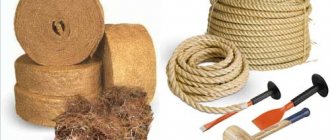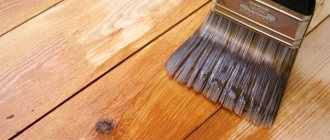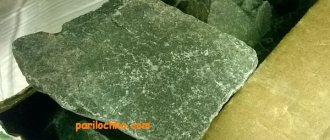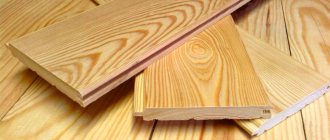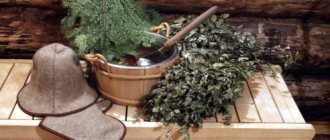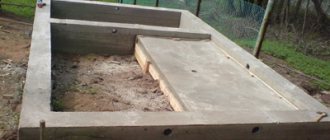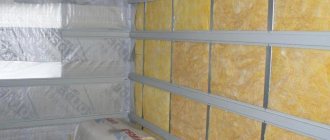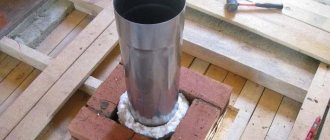Baths can be found in many Russian suburban areas. The purpose of the bath is not just washing, but also relaxation, mental and health-improving. During its construction, special attention is paid to thermal insulation: due to the fact that very aggressive conditions for building materials are created inside the room (temperature changes, humidity), not every insulation is suitable for these purposes. So, in today’s article we will tell you everything about bath insulation - which one is better to use in a particular case, what to look for when choosing, what nuances should be kept in mind during installation.
Bath insulation - which one is better?
On a note! Our rating includes the 7 best thermal insulation materials for baths, used for both internal and external work. When compiling the selection, technical characteristics, expert opinions, reviews from customers and experienced builders were taken into account.
Insulation of a bathhouse from the inside: materials
Different rooms in the bathhouse have different requirements; we will focus on the steam room and wash room, the features of which are high temperature and high humidity. Also, the insulation is selected depending on the material of the bath walls.
But, regardless of the material of the walls and the purpose of the room, the insulation must be:
- Non-toxic so as not to cause poisoning when exposed to high temperature;
- Not hygroscopic, so as not to absorb moisture;
- Resistant to high temperatures and steam;
- Non-flammable;
- Maintaining its shape even after several years of extreme use;
- Resistant to fungi and mold;
- Sold at a reasonable price.
Why is thermal insulation needed?
The bathhouse has many useful properties, but many of them may not be available if the internal insulation is not properly organized. In such a situation, even competently implemented construction work will not save you: if the walls of the building are not able to retain the heat created by the stove, the comfort of taking bath procedures will noticeably drop. The only way out is to reduce the time between kindlings, which, accordingly, will provoke an increase in financial costs for paying for energy resources.
A more correct solution is to insulate the bathhouse; fortunately, there are a number of effective technologies for this. It is best to do this during the construction of the building. However, if this important stage was missed for some reason, some methods of internal insulation can be implemented after construction is completed. The main difference between thermal insulation of a bathhouse and a similar procedure in an ordinary house is that in the first case, it is necessary to maintain the high temperature created by the stove for as long as possible inside the room. This requires a better approach to carrying out work.
Good thermal insulation means maximum energy efficiency for steam rooms and baths Source silpovoyage.ua
Bath insulation
| Insulation | In what room is it used? | Note |
| Natural materials: rolled jute, felt, insulation made from reeds and sawdust, moss, tow, etc. | Dressing room, rest room. | Natural materials ignite at high temperatures, so they are not suitable for steam rooms and washrooms. But materials made from jute and flax are the best inter-crown insulation for a chopped bath. There are excellent modern roll insulation materials made from natural materials, but they are very expensive, so they are practically not used for insulating baths. |
| Mineral insulation. | They can insulate any bathhouse. Most often, slab insulation boards (mats) that are easy to install are used. | They do not rot, last up to 30 years, are fire resistant, and inexpensive. Most Russian baths are insulated with these materials. |
| Polymer materials | FORUMHOUSE craftsmen do not recommend it for insulating a steam room. | Polystyrene foam is an excellent heat insulator, but it is flammable, and at high temperatures it releases substances harmful to humans. You cannot use polystyrene foam in the steam room . Extruded polystyrene foam or penoplex is considered a safe material (it is used to insulate the bathhouse of Russian polar explorers in Antarctica). But FORUMHOUSE experts do not recommend using this material in a steam room. |
| Insulation based on aluminum foil. | It is used in accordance with the manufacturer's recommendations for a specific room. | The principle of operation of such insulation is the effect of a thermos, the reflection of heat from the walls and ceiling due to foil. Some types of foil insulation are produced specifically for steam rooms and other rooms with high temperatures, while others begin to release harmful substances when the temperature rises. Foil in the bathhouse is used as a vapor barrier. |
To sum it up. Let's make the right choice!
When insulating a bathhouse, the most important thing is to choose the right insulation wisely, because the microclimate as a whole and the productivity of the entire insulation depend on the characteristics of the selected material. What is typical is that you can use several different insulation materials in one bath at once in order to achieve the desired effect.
Note! The rating of materials and other information presented in the article are purely subjective; this is not a buying guide, much less an advertisement! Therefore, before choosing this or that insulation, it is advisable to consult with a good specialist.
Insulation of the bathhouse ceiling from the inside
The bathhouse is insulated from the inside in the following order: ceiling - walls - floor. The main part of the heat in the bathhouse is lost through the ceiling, so
The thickness of the ceiling insulation is twice the thickness of the wall insulation and is at least 10 cm.
This is how an authoritative member of FORUMHOUSE with the nickname KochevniK recommends insulating the ceiling.
Nomad
We hang at least 10 cm of insulation under the black ceiling. I really don’t recommend basalt wool, glass wool and polystyrene foam in the steam room. The insulation can be hung with lacing. Then foil, gap along the slats and lining.
Regardless of the material of the walls of the bathhouse, the ceiling is insulated in the same way.
When insulating ceilings, foil is mandatory.
Expanded clay
Fine bulk material in the form of clayey porous stones. The manufacturing technology involves high-temperature firing of clay. Expanded clay granules can have different sizes, which affects the thermal insulation properties of the material. For a bath, it is better to use filler with smaller fractions.
Can be used as ceiling or floor insulation in a bathhouse. When insulating the ceiling, the layer of expanded clay will be 20-30 cm, which, for example, is justified if there is no attic in the bathhouse.
Let us note the main advantages of expanded clay:
- The product is environmentally friendly. Without toxic impurities.
- The low thermal conductivity of the material explains the high energy efficiency of thermal insulation.
- Frost-resistant material, able to withstand regular heating and cooling cycles.
- Does not attract mice and other rodents.
- Biologically resistant to mold and fungal colonies.
- The fire resistance of the material allows it to be used in potentially fire hazardous areas.
- Cheapness.
Serious disadvantages include:
- Fragility of expanded clay granules. Working with it is not as easy as it might seem at first glance. Damaged material granules lose their thermal insulation properties.
- High water absorption due to the porous structure of the fractions dictates the mandatory use of high-quality waterproofing.
Insulation of a frame bath from the inside
To insulate a frame bath, rolled mineral insulation is most often used.
The thickness of the insulation depends on the type of operation of the bathhouse: if you plan to heat it only in the summer, a layer of 5 cm is enough; if you plan to heat the bathhouse all year round, the insulation layer should be 10-15 cm (depending on the climate zone).
To insulate the walls of a frame bath from the inside:
- Insulation is placed in the interbeam space of the structure;
- The next layer is vapor barrier (foil);
- Ventilation gap;
- Sheathing.
The photographs below show how KochevniK insulated his frame bathhouse. Insulation – basalt wool.
Insulating a bathhouse from the inside with your own hands: step-by-step instructions.
Foil acts as a vapor barrier, so it is important that there are no even the slightest holes or damage in it, and that all joints are well taped with high-quality tape. The tape is always sold together with foil, and its quality must be checked in the store (glue the tape to the foil and try to tear it off).
"TechnoNIKOL"
Insulation for baths "TechnoNIKOL". Russian mineral wool goes on sale in a wide range. In private construction, three lines are used: “Rocklight”, “Technoblock”, “Technoacoustic”. All three types are suitable for both internal insulation, performed by specialists or with your own hands (using a vapor barrier), and for external work under siding.
Of all the types of fire-resistant wool produced by this manufacturer, TechnoNIKOL stitched mats (basalt insulation for baths), which do not contain phenols, are best suited for . In the manufacture of other types of products (TECHNO 03B, 03D, 03M boards), a low-phenolic binder is used.
Insulating a bathhouse from the inside with your own hands: log house
Insulating a chopped and well-caulked bathhouse from the inside would be a tragic mistake. This is not only pointless and destructive for the walls, it contradicts the very idea of a chopped bathhouse.
Log houses for baths are made for two reasons:
- To get a classic Russian steam bath, which takes a long time to heat and maintains the required level of heat and humidity for a long time. It is the tree that accumulates heat and moisture and gradually “gives it away”. In this case, the inside of the bathhouse cannot be lined; You will also have to come to terms with the high consumption of firewood.
- For the image. No bathhouse looks as cool in appearance as a chopped one. But I often don’t want to waste time and firewood; I want the bathhouse to be heated in an hour, so insulation, vapor barrier and clapboard cladding are done. The log house works only as an external frame; the meaning of the material is lost. In this case, it is cheaper and more correct to build a frame bathhouse.
It happens that a person gets a ready-made bathhouse from a log house, and for various reasons it can be cold. Such a bathhouse can be insulated, but only from the outside.
The pie looks like this:
- insulation;
- wind protection;
- vertical sheathing to create a ventilation gap;
- outer skin.
And you can put foil on the inside and line it with clapboard, not forgetting about the ventilation gap.
Here's what KochevniK recommends:
- We put foil on the beam and fasten it with a construction stapler;
- We seal ALL joints with foil tape;
- We fill the vertical slats with a thickness of 1-2 cm;
- We fill the lining horizontally, leaving gaps at the top and bottom for air circulation.
In a chopped bathhouse, only the floor and ceiling are insulated!
If the ceiling of a chopped bathhouse is made of thick boards, it is not necessary to use insulation, but then the following is poured onto the ceiling in a cold attic:
- ash;
- sand;
- expanded clay (it is preferable that the granules be of different sizes);
- clay coating.
Vapor barrier properties
LOGICPIR insulation is laminated with vapor-proof foil - this eliminates the need for a separate vapor barrier layer. This will be confirmed by all professionals who know that only aluminum foil can be considered a full-fledged heat-resistant vapor barrier.
When gluing the joints of the plates with foil tape, a continuous and sealed vapor-tight layer is obtained, which reliably protects the entire structure from moisture. The foil does not allow moisture to pass through and reflects heat, like a mirror: it returns up to 95% of the energy of infrared rays from the sauna stove into the room.
Thanks to this, the bathhouse heats up faster, and the insulation layer becomes a reliable barrier between air with high and low temperatures. LOGICPIR retains heat in the room, like a warm fur coat.
Insulation from the inside of a brick bath
Brick is not the most suitable material for building a bathhouse, but if there is a brick factory somewhere nearby, then brick bathhouses begin to grow like mushrooms. Due to the high thermal conductivity of brick, such a bathhouse requires insulation without fail. Insulation is carried out only from the inside, and to make the bathhouse look cool from the outside, decorative jointing is done.
Typically, the pie of an insulated wall of a brick bath looks like this:
- brickwork;
- waterproofing,
- insulation;
- vapor barrier;
- sheathing
Waterproofing between the brickwork and the insulation is optional: if the walls are built correctly and waterproofed from the foundation, they will not become damp. If there is no confidence in the walls, then it is better to do waterproofing.
The insulation on the brick walls of the bathhouse is attached to the frame.
S4sha Member FORUMHOUSE
We build a frame on the wall from 100×40 timber with insulation width increments, fill it with insulation, lay a vapor barrier, sew on 20mm slats and cover it with clapboard.
Our user S4sha’s bathhouse is made of half a brick, but it steams just fine even at -30. Its walls are insulated like this:
- mineral wool;
- vapor barrier (in the steam room - foil);
- ventilation gap;
- lining.
Insulation thickness – 50 mm.
What should heat insulators be like?
The insulation for saunas and baths, which is to be selected for insulation, must have the following qualities:
- be combined with the materials used in the construction;
- be consistently durable, not losing its qualities due to temperature changes;
- resist the occurrence of condensation and the development of destructive manifestations of a biological nature;
- be moisture resistant and have excellent insulating properties;
- contain environmentally friendly ingredients and have a certificate confirming compliance with sanitary standards;
- create conditions for convenient installation and the possibility of finishing with a heat insulator along the entire contour of the log house without cracks and holes.
Insulation of a bathhouse made of blocks from the inside
For the construction of a bathhouse, durable and moisture-resistant blocks of expanded clay concrete are preferred. The insulation of such a bathhouse is thought out at the stage of its construction. The most important thing here is to remove the icy mass of concrete from the heating circuit. There is a technology promoted by our user ZYBY, which allows us to solve this problem by constructing a frame wall from boards with an indentation from the walls of the bathhouse. It is suitable for insulating all baths with stone walls.
To ventilate and dry the space between the frame and the walls, several vents are made in the walls of the bathhouse, at the top and at the bottom outside. The vents are closed while people are steaming in the bathhouse; the rest of the time they are open for drying.
Insulation cake for steam rooms and washing rooms using this technology:
- concrete wall with vents;
- insulation on the frame-wall (with an indentation from the concrete wall);
- frame-wall;
- foil;
- finishing with 50th unedged board (aspen, linden or cedar) to get solid wood in the steam room.
With this approach, there is no need to heat the ice walls. And the insulation will dry out between steaming sessions.
But many owners of a block bathhouse insulate it from the inside traditionally:
- concrete wall;
- insulation (attached to the frame);
- foil;
- ventilation gap;
- lining.
Insulation of a bathhouse made of expanded clay concrete blocks from the inside.
Such a bathhouse needs insulation from the outside as well.
Penoizol
Penoizol is a foam insulation material that resembles liquid foam in appearance. It is applied according to the principle of working with polyurethane foam. The technology for applying penoizol to surfaces involves working only with frame systems. In liquid form, the material expands and fills the space between the guides. Hardening occurs after 10 minutes, and maximum strength is achieved after three days.
Pros of penoizol:
- Good thermal conductivity.
- Good sound insulation performance.
- Fire resistance. The material belongs to the G1 flammability class, that is, it does not burn and does not support combustion. When heated, it does not emit toxic substances.
- The material is elastic. With its help, you can insulate hard-to-reach places. The foam will fill all cracks and voids, eliminating the formation of cold air bridges.
- Strength. Cured foam has a low linear deformation rate.
- Not interesting to rodents and microorganisms.
The disadvantages include:
- The high percentage of water absorption calls into question the use of the material inside a bathhouse or sauna.
- The relatively high cost of application is due to the use of special equipment, which can only be provided by professional organizations.
Penoizol is not recommended to be applied as a heat insulator on surfaces in direct contact with the steam room in a bathhouse, since temperature cycles can reduce the physical properties of the insulator. It can be used to finish the floor or walls in adjacent rooms and on slopes inside the bathhouse in the attic.
Bathroom floor insulation
Precious bath heat also escapes through the floor, so it also needs to be insulated. To insulate the floor in a bathhouse, it is recommended to use expanded clay as the lightest and most environmentally friendly material.
Expanded clay is poured between layers of concrete floor as follows:
- pour the first layer of concrete;
- wait until it hardens completely;
- expanded clay is poured (layer thickness - 10 cm);
- install reinforced grating.
- pour a layer of concrete;
- make a cement-sand screed.
Opportunities for achieving ideal results
Efficiency in arranging the best insulation can be achieved by combining several materials.
The process of insulating walls in a bathhouse
Some owners decide to build a “warm floor” system in the bathhouse, which will require special insulation. For other bath designs the following can be used:
- various granular backfills;
- lightweight extruded insulation;
- material consisting of fibers;
- specialized mats, slabs, rolls;
- liquid insulation of polymer origin.
Various layers of polyethylene film and kraft paper used in the dressing room can also be used for insulation. A mixture prepared according to a folk recipe is suitable: sawdust mixed with clay or a similar composition. You should not use roofing felt and roofing felt as insulation, which emit harmful fumes.
Heat resistant cables
Choosing a non-flammable cable for steam rooms is a fairly responsible procedure that affects not only the operational reliability of the installed wiring, but also the safety of people in the bathhouse.
Since the temperature inside the steam room can reach plus 170 degrees (with a humidity level of up to 90 percent), the cable products installed in it must have the appropriate characteristics. For these purposes, it is recommended to select special samples of waterproof and heat-resistant cable products in a non-flammable sheath, the quality of which is confirmed by certificates.
What is basalt wool
It has already been mentioned that basalt insulation belongs to the group of mineral materials. Its distinctive feature is the production raw materials used. To obtain the fibers of the future heat insulator, rock materials are used. Therefore, basalt wool is often called stone wool.
The production technology involves obtaining a liquid rock melt in a furnace at 1400-1500°C, from which fiber is drawn. Binding components are used to bind the resulting fibers into a homogeneous array. Correct selection of the binder base helps to significantly improve the characteristics of stone wool. After forming the structure, setting the direction of the layers and obtaining the required density, the finished material is cut to a standard size and packaged. Forms of release: mats, soft rolls, hard slabs.

